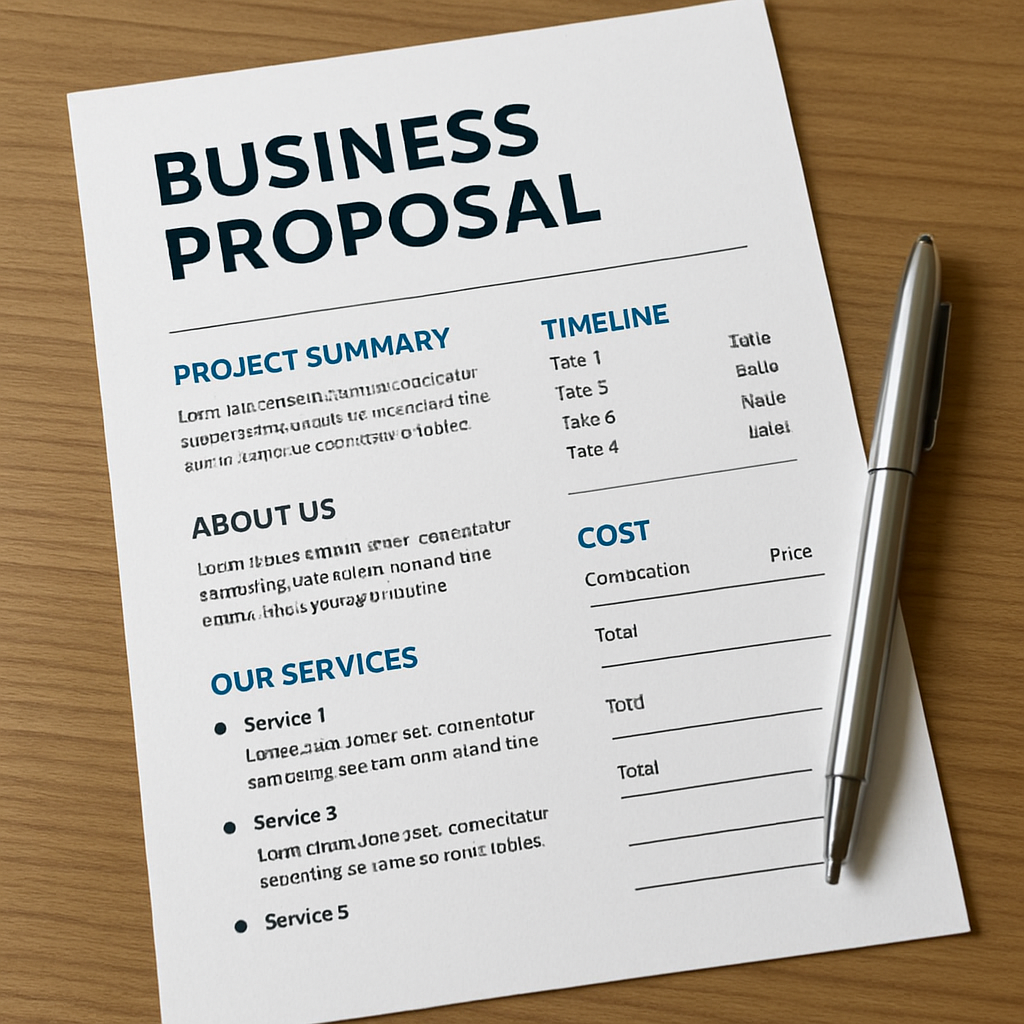Essential Elements of a Business Proposal Template
Creating a business proposal can be daunting. Yet, it's a crucial step in winning new clients.
A well-crafted proposal can set you apart from competitors. It showcases your understanding of the client's needs.
But what makes a business proposal effective? The answer lies in its structure and content.
A business proposal template can be your best ally. It ensures consistency and saves time.
Templates guide you through the essential elements. They help you focus on what matters most.
From the title page to the call to action, each part plays a role. They work together to persuade and inform.
Understanding these elements is key to success. It allows you to tailor your proposal to each client.
This guide will explore the essential elements of a business proposal template. You'll learn how to use them effectively.
By the end, you'll be equipped to create compelling proposals that drive business growth.
What Is a Business Proposal? Understanding the Basics
A business proposal is more than just an offer. It’s a document that outlines your business plan to provide goods or services to a potential client.
Proposals can be the key to opening doors to new business opportunities. They deliver your solutions directly to your client's needs.
Understanding what constitutes a solid proposal is essential. This knowledge can differentiate your business from the competition.
Business proposals typically fall into two categories: solicited and unsolicited. Both require clarity and persuasion to be effective.
A successful proposal must contain essential elements. These include a captivating title, a clear solution, and a strong call to action.
Let's look at the main parts of a business proposal:
- Title Page
- Executive Summary
- Problem Statement
- Proposed Solution
- Timeline
- Pricing
- Terms and Conditions
Each component plays a significant role. Together, they form a narrative that entices the client to engage with your company.
Understanding the basics of business proposals sets the foundation for success. It ensures your proposal is clear, professional, and persuasive.
Business Proposal vs. Business Plan: Key Differences
Business proposals and business plans serve different purposes. While they sound similar, each has a unique function in the business world.
A business proposal is crafted to offer goods or services to potential clients. It's often used in sales and project bidding.
Conversely, a business plan is an internal document. It outlines the strategy and direction of a business for stakeholders and management.
Here are the key differences:
- Audience: Proposals target clients, while plans focus on internal teams.
- Purpose: Proposals aim to convince clients, plans guide growth.
- Content: Proposals are client-focused, plans are operations-focused.
Understanding these differences is critical. It ensures that each document serves its intended purpose effectively.
by Kelly Sikkema (https://unsplash.com/@kellysikkema)
Types of Business Proposals: Solicited and Unsolicited
Business proposals come in two main types: solicited and unsolicited. Each type serves different scenarios and requires a unique approach.
Solicited proposals are responses to specific requests from clients. They follow client-defined criteria, ensuring all client expectations are addressed.
Unsolicited proposals, on the other hand, are initiated by the business itself. They aim to intrigue potential clients without an explicit request.
Here's a brief overview of the differences:
- Solicited Proposals: Requested by clients, follow specific guidelines.
- Unsolicited Proposals: Initiated by the business, require persuasive tactics.
Crafting a solicited proposal often involves adherence to strict specifications. This type requires meeting precise instructions set by the client.
Unsolicited proposals demand creativity and initiative. They must capture the client's interest and clearly communicate value.
by Wesley Pribadi (https://unsplash.com/@wesleypribadi)
Why Use a Business Proposal Template?
Using a business proposal template streamlines your process. It saves time and reduces errors by providing a consistent format.
A well-designed template ensures all critical elements are included. This keeps your proposal clear and comprehensive.
Consider these benefits of using a template:
- Consistency: Uniformity across all proposals.
- Efficiency: Speeds up proposal preparation.
- Clarity: Ensures no key elements are missed.
Templates also allow easy customization for different clients. This flexibility helps tailor your proposal to specific needs.
By adopting a template, you maintain focus on content quality rather than format. This shift enhances professionalism.
by Dima Rogachevskiy (https://unsplash.com/@madd_dogg)
Essential Elements of a Business Proposal Template
Crafting an effective business proposal requires certain key elements. Each component plays a vital role in persuasiveness.
Including essential parts ensures clarity and engagement. This is crucial for winning over potential clients.
Here's a breakdown of the main components:
- Title Page: Introduces the proposal
- Executive Summary: Provides an overview
- Problem Statement: Identifies client needs
- Proposed Solution: Offers a detailed plan
The remaining sections build on these core elements. Together, they create a coherent narrative.
by FORTYTWO (https://unsplash.com/@byfortytwo)
1. Title Page
The title page serves as the proposal's introduction. It should capture attention and provide basic details.
Include the proposal title, your company's name, and date. Contact information is also vital.
A well-designed title page sets a professional tone. It invites the client to explore further.
- Proposal Title
- Your Company Name
- Date and Contact Information
by Brett Jordan (https://unsplash.com/@brett_jordan)
2. Table of Contents
The table of contents helps clients navigate the proposal. It lists all sections in order for easy reference.
This section is vital, especially for lengthy proposals. It ensures quick access to specific information.
- Lists major sections
- Increases proposal’s usability
A comprehensive table aids in efficient decision-making by clients.
3. Executive Summary
The executive summary is a concise overview. It highlights the main points of the proposal.
This section should capture attention quickly. It is often the first page a client reads.
Key elements include:
- Purpose of Proposal: What are you offering?
- Major Benefits: How will the client benefit?
- Summary of Solution: Brief outline of the proposed plan
Include engaging and persuasive language. This sets the stage for a deeper exploration.
by Walls.io (https://unsplash.com/@walls_io)
4. Problem Statement
A clear problem statement defines the client's need. It shows your understanding of their challenges.
Detailing the problem builds your credibility. It demonstrates relevance and helps tailor your solution.
Elements to consider:
- Client Needs: What problem exists?
- Impact: How does it affect the client?
- Urgency: Why address it now?
A well-crafted problem statement generates empathy and sets up your solution.
by Jatin Jangid (https://unsplash.com/@jatin_graphix)
5. Proposed Solution
The proposed solution outlines your approach. It provides a comprehensive plan tailored to the client’s needs.
Describe how your solution addresses the problem. Be specific and detailed to establish viability.
Key elements:
- Solution Details: What will you do?
- Benefits: How will it improve the client's situation?
- Unique Value: What makes it stand out?
Ensure clarity and relevance to make a compelling case.
by Amsterdam City Archives (https://unsplash.com/@amsterdamcityarchives)
6. Qualifications and Experience
Showcase your credentials through qualifications. This builds trust and gives assurance to clients.
Highlight relevant experience and expertise. Mention past successes and industry recognition.
Consider these points:
- Experience: Demonstrated track record
- Skills: Relevant to the proposed solution
- Recognition: Awards or certifications
Providing evidence of qualifications bolsters confidence in your capability.
by Brett Jordan (https://unsplash.com/@brett_jordan)
7. Project Timeline and Milestones
A clear timeline outlines the project's phases. It establishes expectations and accountability.
Include key milestones and deadlines. This helps clients visualize the progress and completion.
Key components to include:
- Project Start and End Dates
- Milestone Descriptions
- Deadlines
A structured timeline fosters transparency and keeps all parties aligned.
by Behnam Norouzi (https://unsplash.com/@behy_studio)
8. Pricing, Payment, and Terms
Be transparent about pricing and payment. This section should match the proposal’s value.
Break down costs and payment terms clearly. This aids in decision-making and avoids confusion.
Consider including:
- Pricing Details: Itemized costs
- Payment Terms: Schedule and methods
- Value Justification: Why the cost is reasonable
Clear financial terms build trust and facilitate negotiations.
by Lance Anderson (https://unsplash.com/@lanceanderson)
9. Terms and Conditions
Terms and conditions define the agreement. They cover legal and financial aspects.
It's important for clarity and avoiding disputes. Ensure they are straightforward and comprehensible.
Include:
- Legal Terms: Rights and obligations
- Financial Terms: Budget specifics
- Other Conditions: As necessary
These aspects ensure mutual understanding and protection for both parties.
10. Call to Action and Next Steps
End with a strong call to action. This prompts the client to move forward.
Outline the immediate next steps. This guides the client on how to proceed.
Include:
- Contact Information: Who to reach out to
- Action Steps: What to do next
A clear call to action can greatly improve proposal success.
Customizing Your Business Proposal Template for Success
Customization is key to proposal effectiveness. Tailor each proposal to the client's unique needs and circumstances.
Begin by researching the client's industry and objectives. This ensures your proposal is aligned with their goals.
Consider these customization steps:
- Understand Client's Needs: Research their problems and goals.
- Personalize Language: Use terms and references relevant to the client.
- Include Specific Data: Highlight data or case studies pertinent to their industry.
Personalization demonstrates your genuine interest and understanding. It makes your proposal more persuasive.
Remember, a well-customized proposal speaks directly to the client's situation. This increases the likelihood of a favorable response.
by Joonas Sild (https://unsplash.com/@joonas1233)
Best Practices for Writing a Winning Business Proposal
Crafting a winning proposal requires attention to detail and strategic thinking. Focus on clarity and relevance to the client's needs.
Start with a compelling introduction. This sets the tone and captures the reader's interest.
Structure your proposal logically to enhance readability. Each section should flow naturally into the next.
Incorporate these best practices:
- Clear Language: Avoid jargon and keep it straightforward.
- Client Focus: Tailor content to address their specific challenges.
- Visual Aids: Use charts and graphs to clarify complex points.
Feedback is invaluable. Seek input from colleagues to refine the proposal before submission.
Finally, proofread thoroughly. Errors can undermine credibility and distract from your message.
by Hyoshin Choi (https://unsplash.com/@hyoshining)
Visuals, Design, and Formatting Tips
A visually appealing proposal captures attention and improves comprehension. Simple yet effective design elements can make a difference.
Choose a clean and professional layout. This enhances readability and ensures that your message is clear.
Use visuals wisely to illustrate key points. They can break up text and provide clarity on complex concepts.
Consider these design tips:
- Consistent Fonts: Use readable fonts and consistent sizes.
- Color Scheme: Choose colors that align with your brand and are easy on the eyes.
- White Space: This allows content to breathe and reduces clutter.
A well-formatted document conveys professionalism. Consistency in design fosters credibility and reflects your attention to detail.
by Sigmund (https://unsplash.com/@sigmund)
Common Mistakes to Avoid in Business Proposals
Writing a successful business proposal requires careful attention to detail. Common mistakes can undermine your efforts and weaken your proposal.
One frequent error is overlooking the client's specific needs. Tailoring your proposal to address these needs is crucial.
Avoid using complex jargon or overly technical language. This can obscure your message and alienate your audience.
Ensure that your document is free from spelling and grammar errors. Such mistakes can detract from your professionalism.
Consider these potential pitfalls:
- Generic Content: Tailor each proposal to the recipient.
- Over-Promising: Be realistic about what you can deliver.
- Neglecting Layout: A cluttered design can confuse readers.
Missing a clear call to action is also a common issue. Encourage the client to take the next steps.
Remember, a well-crafted proposal not only persuades but also builds trust and credibility.
by Joonas Sild (https://unsplash.com/@joonas1233)
Using Digital Tools and Software for Proposal Creation
In today's digital age, technology can greatly enhance proposal creation. Software tools streamline the process and improve efficiency.
These tools offer a variety of templates, making it easier to maintain consistency. They often include collaborative features for team input and review.
Automation features can reduce time spent on formatting and organization. This allows you to focus on content quality and customization.
Key benefits of using digital tools include:
- Time Savings: Automate repetitive tasks to focus on strategy.
- Collaboration: Foster teamwork with shared access and feedback capabilities.
- Professional Appearance: Use polished templates for consistency and appeal.
Embracing technology ensures that your proposals are both professional and tailored to client needs.
Using the right software transforms a tedious task into an efficient, streamlined process. It not only saves time but also enhances proposal quality.
by Courtney Cook (https://unsplash.com/@courtneymcook)
Frequently Asked Questions About Business Proposal Templates
Understanding business proposal templates can raise several questions. Here, we address some common queries to clarify any uncertainties.
What is the purpose of a business proposal template?
A template provides a consistent structure, saving time and ensuring completeness. It helps present ideas clearly and professionally.
How detailed should a business proposal be?
The proposal should be detailed enough to cover all necessary aspects, but concise to keep the client's interest. Balance is key.
Can I customize the template for specific clients?
Absolutely. Customization enhances relevance and appeal. Tailor details to align with the client's industry and specific needs.
Are templates suitable for all industries?
Yes, templates are flexible and adaptable. Whether tech, finance, or health, they can be modified to fit industry-specific requirements.
What tools can help in creating proposals?
Digital tools like Microsoft Word, Canva, or proposal software streamline creation. They offer design and collaboration features for effective results.
By addressing these questions, you can confidently use business proposal templates to craft compelling proposals.
Conclusion: Building Better Proposals for Business Growth
Crafting a persuasive business proposal is vital for growth. It solidifies your pitch and showcases your expertise.
A comprehensive proposal goes beyond mere structure. It highlights understanding of client needs and offers tailored solutions.
By integrating these elements, your proposals can stand out and inspire confidence in potential clients. Emphasize clarity and value proposition.
Remember these key points for creating compelling proposals:
- Align with client goals.
- Customize proposals for relevance.
- Maintain a professional and engaging tone.
The power of an effective business proposal cannot be underestimated. It acts as a bridge between service offerings and client needs. By refining your approach and utilizing structured templates, you set the stage for enhanced business opportunities and long-term partnerships. Leverage this tool to propel your business toward sustained success.




